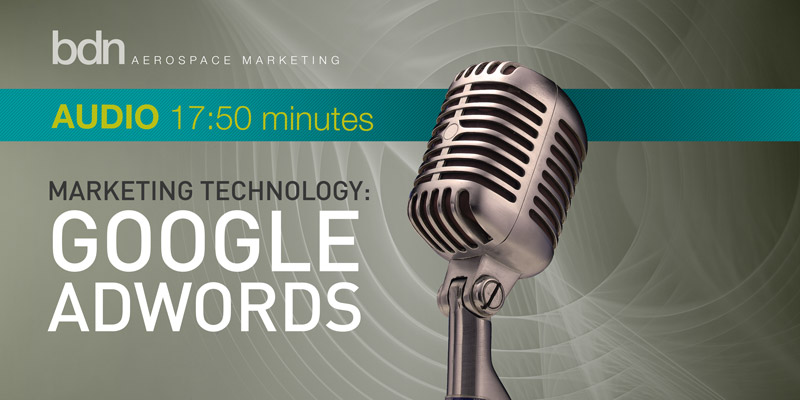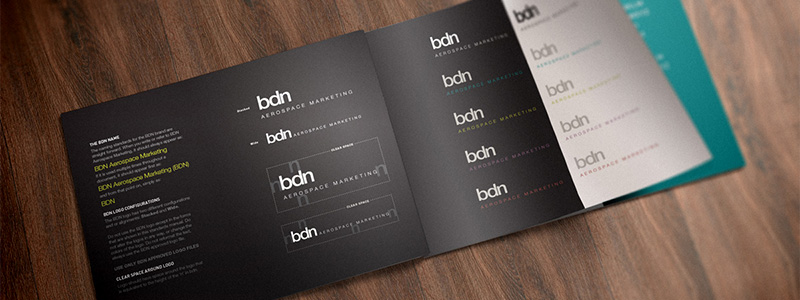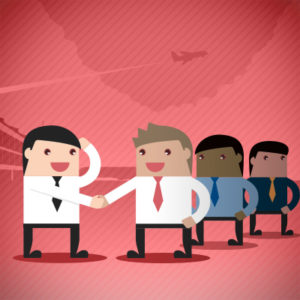Category: BDN
Audio: Let’s Talk About Google AdWords
There’s a lot to love and to learn about digital marketing. It’s a broad and ever-changing topic, and the source of many questions from clients and prospects. We are often asked specifically about Google AdWords. It’s a highly affordable and trackable marketing tactic, which are big draws for aerospace marketers. More specifically, it’s defined as an advertising service by Google for businesses wanting to display ads on Google and its advertising network. The AdWords program enables businesses to set a budget for advertising and only pay when people click the ads. The service is largely focused on keywords.
In addition to asking what AdWords is, people often ask us how it works…and if it works…in our industry. The old schoolers will tell you no and laugh you out of the room. We will tell you yes — but it’s not an unqualified yes. Your success with Google AdWords, like any marketing tactic, depends on understanding the tool, your audience and your goals for each campaign.
In this week’s audio program, Nick Markwardt interviews BDN team member Sarah Stanczyk, who walks us through this powerful marketing tool, offering useful information and tips for success every step of the way.

[vc_separator type=”” size=”” icon=”plane”]
Want to know more about digital marketing for aerospace and defense? Here’s some additional content you may find useful:
Audio: Highlights from NBAA 2016
Last week, several members of the BDN team attended NBAA’S Business Aviation Convention and Exhibition — the world’s largest business aviation trade show. This venue has proven to be a bellwether of trends and economic vitality for the civil aviation market. All of the major players in business aviation were well represented in Orlando, and while the total number of exhibitors may have been up, consensus was that attendance numbers were flat. That’s not to say that there weren’t new products and announcements to get excited about, only that it was “business as usual” at this annual show.
In this week’s audio program — recorded at the end of day two of the conference — business development executive Ashley Cutler and senior designer Nick Markwardt discuss their observations and highlights from this year’s show.

[vc_separator type=”” size=”” icon=”plane”]
Download our 2017 A&D Trade Show Directory here. We will continue to add events as organizers finalize and make those details available.
Editor’s Note: Nick references the Wittman Museum while describing the EAA experience. It is actually the EAA AirVenture Museum at Wittman Regional Airport.
The Technology Imperative: A Tipping Point for Serious Aerospace Marketers
 The most successful aerospace businesses are changing the way they market, wisely leveraging technology for maximum efficiency and effectiveness. So this week we take on the topic of technology and suggest how aerospace marketing professionals can use technology to fundamentally change the way they market and sell — for the better.
The most successful aerospace businesses are changing the way they market, wisely leveraging technology for maximum efficiency and effectiveness. So this week we take on the topic of technology and suggest how aerospace marketing professionals can use technology to fundamentally change the way they market and sell — for the better.
Some marketers always seem to be overwhelmed, unable to keep up with an ever-expanding list of demands for ads, collateral, PR, and trade show support.
Their focus is on delivering a collection of stuff, or outputs, and they do it very well. Sadly, they are probably too busy to notice that their skills are rapidly becoming, at worst, irrelevant — and at best, a commodity.
Other marketers are less frenzied and more in control. They have evolved the marketing process to match the needs of B2B buyers and use data-driven methods to ensure that marketing is driving results.
Their focus is on delivering outcomes. They are masters of marketing and technology, are highly employable, and extremely well compensated.
Meet MarTech.
If you haven’t done so already, maybe it’s time to change the way you market and sell by using marketing technology (MarTech).
MarTech is any technology that helps marketers be more efficient or effective in reaching their audiences at the right time with the right offers. It’s ideal for marketers dealing with tight budgets and is well suited to lengthy aerospace buying cycles. It encompasses everything from email to predictive analytics, and supports each stage of the sales funnel, from awareness and evaluation to purchase and advocacy.
And because MarTech tools are digital, they are infinitely more trackable and measurable than traditional marketing methods.
No wonder B2B companies are using and investing in MarTech like never before. MarketingProfs recently published the results of a study from Informatic, Dun & Bradstreet and Ascend2 showing that 65% of B2B companies are increasing marketing technology budgets. The study also revealed:
The most-used MarTech tools.
- Email marketing (89%)
- Social media marketing (70%)
- Marketing analytics (61%)
- CRM/Sales automation (58%)
- CMS/Content management (55%)
- Search marketing (52%)
- Marketing automation (49%)
- Data management (37%)
- Testing and optimization (31%)
The most common reasons B2B marketers use MarTech.
- Increase leads (56%)
- Increase sales revenue (53%)
- Increase conversion rates (46%)
- Improve targeting/personalization (38%)
- Improve efficiency/reduce costs (33%)
- Improve technology integration (25%)
- Improve data quality/accuracy (19%)
- Improve behavioral predictability (14%)
It’s Not Easy.
It’s understandable that businesses are apprehensive about adopting new tactics and techniques. Evaluating, purchasing, implementing and optimizing these systems is a tremendous undertaking and not without risk. But the real risk, to both your career and your business, is refusing to change, and like it or not, this is our new reality. With this in mind, are you interested in changing the role and contribution of marketing in your organization?
Get smart
Learn everything you can about MarTech. Check out options like Google Analytics 360 (Tracking), Hubspot (CRM and Automation), WordPress (CMS), AdRoll (Remarketing and Retargeting), Moz Pro (SEO), and Buffer (Social Media).
Set goals
What do you expect MarTech to accomplish, and how will you measure success?
Develop a plan, budget and schedule
What steps will you take to achieve your goals, what will it cost, and how long will it take? What is the expected return on investment?
Take things one step at a time
…and remember that it’s OK to start small (as long as you start). Getting a CRM, if you don’t have one, should be your very first step. It’s a must and a bare minimum for every marketing organization.
Get management, sales and IT buy-in
Without this organizational support you will certainly fail. Making sure that sales is on board is especially critical, and enormously tricky. MarTech fundamentally changes the relationship between sales and marketing, giving marketing more control over more of the process, and making sales accountable.
Try before you buy
Demo any system you are considering, and ask to speak with current customers. They’ll tell you the truth about the implementation and integration process.
Training, Training, Training
According to Lead MD, marketing technologies are only as intelligent as the users behind them. “Without a solid foundation of strategies, benchmarks, and training, users often apply old tactics and behaviors to the new platform, which then delivers similar results.”
Commit to using the system
Lead MD also says that non-technical teams often get comfortable with one or two basic features and settle into a pattern, ignoring the rest of the platform. Usually this takes the form of using marketing automation as a blast email system instead of exploring all of its rich potential.
Be transparent
Be honest and open about what’s working, and what’s not, with everyone on the team. Create a sense of shared destiny and come together to make improvements.
Don’t get distracted
There will always be shiny new software from a tech company making big promises. Don’t get distracted by the next big thing, and stay focused on accomplishing your goals.
Be flexible
There’s no single formula or one-size-fits all solution. Some of this is trial and error, and learning as you go. In order to succeed, you have to be willing to occasionally fail.
[vc_separator type=”” size=”” icon=”plane”]
Additional Resources
B2B Marketing Technology: Top Tools, Objectives and Challenges
Start Making Sense: The 17 Most Important Technologies For B2B Marketers
B2B Firms Turn to Marketing Technology to Court Buyers
Establishing Brand Guidelines: From Chaos to Consistency
You’ve come a long way. Whether you worked with an agency or leveraged in-house talent, you’ve created a cohesive and considered plan for the future of your brand. At this point, all that remains is to detail your vision and make it actionable for everyone in your organization.
The document you will create to do this is known as your brand guidelines, brand standards, or style guide. Regardless of the designation, this will be your roadmap and rulebook for creating and maintaining brand consistency.

Here are seven areas that should always be addressed in your brand guidelines.
- Purpose – Don’t take for granted that everyone in your organization understands or comprehends why adhering to a brand standard is important. Including a vision statement and purpose helps to get everyone on the same page.
- Tone – What’s the voice of your brand? Are you authoritative or quirky? When you refer to your company, should it be in first person or third person? Consistency in tempo, sentence length and vocabulary are all factors which should be considered.
- Logo – Be sure to identify all correct formats and color combinations for your logo. Don’t forget to include concepts like clear space (how much empty space to put around your logo), restrictions on backgrounds (solid colors, patterns, and photos) and acceptable sizes and orientations. If your brand has a tagline, it is important to define how it incorporates with your logo and when it is acceptable to use it.
- Color Palette – It is important to define not just the color or colors that appear in your logo, but specify additional colors which may be used to accent the primary colors. These are typically complementary colors, neutrals, or tints of the primary color. At a minimum, provide the values for all the approved colors in Pantone, CMYK and web (hexadecimal).
- Typeface – The power of consistent typography is often overlooked, but type is one of the most vital pieces of a unified brand. Detail which fonts are approved and in what situations they should be applied. For example, you may want to use a highly distinctive font for headlines, but a simple, easy-to-read font for paragraphs and blocks of text. Provide a list of acceptable alternative fonts for use in email, PowerPoint, and other situations where the exact font might not be available.
- Photography – Will your brand feature full-color action photography, moody black and whites, or something else altogether? How will you display your products and what about employee and executive portraits? Regardless of the project, having consistency in your imagery shows that you are a unified organization. Set some ground rules for the quality and required aspects of your photos.
- Brand Champion – When questions arise, approval is sought, or materials needed, who in your organization “owns” the brand? Ideally, this person or team should have knowledge of design, digital and print-production. They should be prepared to serve as “brand police” when necessary, and should have the authority to step in and correct off-brand practices. Provide contact information and define their role within the pages of your brand guidelines.
Remember that creating effective brand guidelines is a balancing act. On one end of the scale, you are creating uniformity by setting boundaries and on the other, you are allowing enough flexibility that designers and team members can create their best work. If you are too restrictive, teams and individuals are likely to “go rogue” and ignore the standards. If you leave it too open to interpretation, you may not achieve the unified front you desire.
Because markets, organizations, and technology are always evolving, brand guidelines serve as a living document. For this reason, many groups choose to keep them digital and host them online. Below are three such A&D industry examples which may serve as a useful reference:
[vc_separator type=”” size=”” icon=”plane”]
This concludes our month-long look at branding. Please join us each week in November where the topic will be marketing technology and we will be reporting on industry trends from NBAA BACE 2016.
What is Branding? Part Three: Brand Deliverables
Developing a brand or rebranding a program for your aerospace business is not for the faint of heart.
Brand work requires discipline, focus, commitment, and, above all, honestly. It’s a two pronged process that first requires assessment and strategic thinking motivated by the company’s vision and long term goals. This is the intangible aspect of branding that should help you…
- Define your competitive landscape
- Define the needs of your prospective customer
- Define a unique relevant brand position to fill those needs
 The second step is visually communicating your new brand and applying it to all aspects of your business. This is the tangible application that creates a strong and unified front for your firm. But with it comes a long laundry list of items that will need to be updated to represent your new brand.
The second step is visually communicating your new brand and applying it to all aspects of your business. This is the tangible application that creates a strong and unified front for your firm. But with it comes a long laundry list of items that will need to be updated to represent your new brand.
To help you identify what these items are, BDN has developed a Branding Deliverables Checklist.
You can download it here.
[vc_separator type=”” size=”” icon=”plane”]
You’ve crossed the rubicon and all the decision makers have blessed your new brand look and feel. Now what? How do you get everyone else in your organization on board?
Fear not. Next week we’ll be looking at how to establish brand standards and what to include in your brand guidelines.
Protect Your Brand with a Solid Architecture
We’ve said it before. Branding is complicated.
It’s especially so for companies that have experienced considerable growth and change – perhaps through mergers and acquisitions or the addition of new products and services — but lack branding discipline. We’ve seen it happen time and time again. A new product name here…an organizational logo there…and pretty soon you’ve lost control. What started with good intentions ends up as a branding free for all, and a really big mess.
The Branding Strategy Insider has seen it before, too, and knows how to spot a problem:
“Frequently, there are no naming standards. Each new product or service is named as it is created, with no view to the overall picture. And sometimes, employees are creating variations or new versions of existing brands for entities and programs such as internal training programs, company picnics or employee reward programs. If some or all of this applies to your organization, you likely need help clarifying and simplifying your branding structure.”
If this sounds like you, you need to take a look at your branding architecture.
Branding architecture is defined as the way a business defines the relationship among its brands and product lines to help people understand what the company offers. It’s a family tree, but with rules covering the number and hierarchy of brands, rules for creating new brands, and the overall branding approach.
And while there are no absolute rules that apply in all brand architecture situations, the Branding Insider offers 12 very solid rules of thumb:
- The simpler the system the better.
- Ideally, there are no more than two levels of hierarchy.
- The system should be flexible enough to address all current and anticipated branding situations.
- The dominant brand should be the one you most intend to build over time.
- Sub-brands should be created sparingly, however they can be built to make the main or parent brand more relevant to new customer segments.
- When an existing brand can be used, new brands should not be created.
- Careful thought should be put into at what level taglines are used.
- Many organizations have evolved to brand/sub-brand systems with some provision for flexibility and variation.
- More and more organizations are trying to build and leverage their corporate, parent or organization brands as a way to save money when marketing products and services.
- Only brands that (a) are highly differentiated, (b) will be maintained for at least several years and (c) will be supported by significant marketing resources over time should have coined names.
- Brand architecture should be designed with external audiences in mind. It should not be designed to reflect legal entities or internal organization structure.
- Sub-brands should be developed to meet the needs of different market segments. This requires a deep understanding of those segments.
[vc_separator type=”” size=”” icon=”plane”]
Aerospace & Defense Industry Tip
There are several common types of brand architectures, and many fall on a spectrum between the branding house and house of brands.

- House of Brands: The company brand acts as a holding company and each product or service is individually branded for its target market
- Hybrid: Sub-brands exist and are linked to the corporate brand through language or visually
- Branded House: The company brand is used on all products and services
Many aerospace and defense businesses fall into the trap of establishing brand architecture around their organizational structure – don’t be one of them! Your brand architecture should be organized to present your brand in the most customer-centric and customer-friendly way possible.
What is Branding? Part One: Branding Glossary
People ask us all the time if BDN is a branding or a marketing agency.
The truth is, we are neither (we really exist to build awareness and enable sales for aerospace businesses) and we are both (branding and marketing are essential elements to building awareness and driving sales).
No wonder it’s confusing.
The word branding, like marketing, can mean many things to many people. So this week we bring you a glossary designed to promote a shared understanding of branding terminology, and a few A&D industry examples to give it wings.
[vc_separator type=”” size=”” icon=”plane”]
BDN Branding Glossary
Brand
A brand is a living business asset that enhances the connection between a business and customer. Some people define it as what people say when you are not in the room, and that’s a good way to think about it. Boeing is the most valuable aerospace brand in the world. Consider what the Boeing brand means to you.
Brand Ambassador
Also called brand champions, these are people within an organization who represent and passionately promote the brand. Richard Branson is a visible and vocal ambassador for Virgin Airlines. Lynn Tilton is the face of MD Helicopters. Is your CEO a valuable ambassador for your brand?

Brand Architecture
This is how a business defines the relationship among its brands to help people understand what the company offers. Many aerospace businesses fall into the trap of establishing and communicating their brand architecture around their organizational structure (versus customer offerings). Don’t be one of them!
Brand Personality
This is the attribution of human characteristics to a brand as a way to achieve differentiation. Your personality should be reflected in how your brand looks, speaks and acts. In our experience, too many A&D brands look (everything is blue) and sound (quality, innovation, reliable solutions, etc.) alike. But being different is marketing gold! Big Ass Fans is an A&D industry brand with a distinct and memorable personality.

Brand Positioning
Also known as brand strategy, this is the distinctive position that a company adopts in the marketplace to ensure differentiation from its competition. A Sikorsky Aircraft Ad campaign — “There Are Those Who Fly, and Those Who Fly Sikorsky — positioned the company as the world’s elite provider of helicopters.
Brand Standards
These are clear rules and guidelines that ensure your brand is presented correctly and consistently in all usages. Does your company have standards? Are they followed and enforced?
Brand Voice
A defined voice is a distinct style of communication that is reflected in an organization’s writing style. What’s your brand voice? Is it simple and straightforward, or complicated and full of buzzwords?
Logo
A logo is the graphic treatment and colors that make your brand immediately identifiable and uniquely ownable. Engineering-minded folks may think the logo must be a literal representation of what you do, and this is why they should not design logos.
[vc_separator type=”” size=”” icon=”plane”]
Next week we’ll take a more in-depth look at Brand Architecture and Brand Positioning. Join us!
Also: If you liked this week’s blog, you may also enjoy:
- Blueprint for Branding
- Realize the Full Value of Your Aerospace Brand
- Does Your Aerospace Business Have a Branding Problem?
- 5 Branding Myths that are Hurting Your Aerospace Business
Credits: Some of these definitions are adapted from a more complete glossary published on brandchannel.com and were originally published in Interbrand.
Aerospace & Defense Media 2017: The Definitive Guide
Do you need to find and reach key audiences for your marketing messages?
Are you looking for editorial contacts or places to advertise your products and services?
This guide to the aerospace and defense industry media can help.
Updated for 2017, it’s available now as you begin planning for next year, with hundreds of entries for relevant media worldwide.
Start Planning Now: The 2017 A&D Trade Show Directory is Here
According to Forrester Research, B2B marketers spend more on trade shows, conferences and events than on any other marketing tactic. They are especially important to aerospace and defense marketers.
That’s why, year after year, this handy directory of aerospace, defense and aviation events is our most popular download. It’s the ultimate industry event reference — and it’s available to you now at no cost, exclusively from BDN Aerospace Marketing.
Download your 2017 A&D Trade Show Directory today, and check back later this year for updates. We will continue to add events as organizers finalize and make those details available.
Lead-Gen for Aviation: How it Works
 Budgets are tight. Expectations are high. And marketing always seems to be on the hot seat to do more. We feel the pressure from management, from finance and, especially, from sales.
Budgets are tight. Expectations are high. And marketing always seems to be on the hot seat to do more. We feel the pressure from management, from finance and, especially, from sales.
Finger-pointing between sales and marketing is nothing new. Salespeople say they don’t get enough support, tools or help from marketing. And marketing folks think sales lacks the discipline and follow-through to close.
It doesn’t have to be this way.
Marketers who embrace lead generation can shift these dynamics once and for all, fundamentally changing the relationship between sales and marketing, giving marketing more control over more of the process and making sales accountable for follow-through. At the same time, they can elevate their profile in the organization and move away from being on the defensive. There are three keys to making it happen:
- Shifting the marketing conversation from outputs to outcomes.
- Working with sales to jointly adopt and use a Customer Relationship Management (CRM) system.
- Implementing successful lead-generation campaigns.
Once marketing starts delivering measurable outcomes that link to sales, everything changes. And if you think lead generation won’t work in aerospace and defense, think again. BDN recently completed a sales and marketing campaign with a focus on lead generation for an avionics business, and the results were nothing short of astounding.
You can learn more in an all-new Success Insider case study, available for download now.
[vc_separator type=”” size=”” icon=”plane”]
If you like this blog you may also enjoy:


